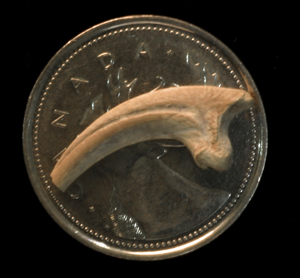
Credit: University of Calgary
In a report published Monday in the Proceedings of the National Academy of Sciences, Canadian paleontologists have once again identified the fossil remains of what is believed to be the smallest nonavian dinosaur ever discovered in North America.
The paper entitled “A microraptorine (Dinosauria–Dromaeosauridae) from the Late Cretaceous of North America,” co-authored by Nicholas R. Longrich of the University of Calgary and Philip J. Currie of the University of Alberta, describes a 1.9 kg dromeosaur, named Hesperonychus elizabethae. The previous record holder, also identified by Longrich and Currie was a chicken-sized insectivore named Albertonykus borealis.
Hesperonychus elizabethae was named for the late paleontologist Betsy Hollis who in 1982 collected a significant Hesperonychus pelvis fossil from Alberta’s Dinosaur Provincial Park.
In the press release paper co-author Nick Longrich makes an interesting point about the curious lack of data on small carnivores:
“Hesperonychus is currently the smallest dinosaur known from North America. But its discovery just emphasizes how little we actually know, and it raises the possibility that there are even smaller ones out there, waiting to be found,” said Nick Longrich, a paleontology research associate in the University of Calgary’s Department of Biological Sciences. “Small carnivorous dinosaurs seemed to be completely absent from the environment, which seemed bizarre because today, the small carnivores outnumber the big ones,” he said. “It turns out that they were here and they played a more important role in the ecosystem than we realized. So for the past 100 years, we’ve completely overlooked a major part of North America’s dinosaur community.”
Couldn’t the specimens represent juveniles? Longrich says no:
“The claws were thought to come from juveniles- they were just so small. But when we studied the pelvis, we found the hip bones were fused, which would only have happened once the animal was fully grown”, Longrich said. “Until now, the smallest carnivorous dinosaurs we have seen in North America have been about the size of a wolf. Judging by the amount of material that was collected, we believe animals the size of Hesperonychus must have been quite common on the landscape.”
Additionally, since the specimens date to a period around 45 mya, we now have better pictures of the chronology for small carnivores:
The discovery of Hesperonychus is the first sign of small carnivorous dinosaurs in North America and also extends the timeframe of small, birdlike dromaeosaurs known as the Microraptorinae in the fossil record by approximately 45 million years. Specimens from China have been found dating to 120 million years ago, while Hesperonychus appeared to have thrived until the end of dinosaur age in the late Cretaceous.
The paper is available behind a pay firewall, but a press release from the University of Calgary includes video.







{ 0 comments… add one now }
You must log in to post a comment.